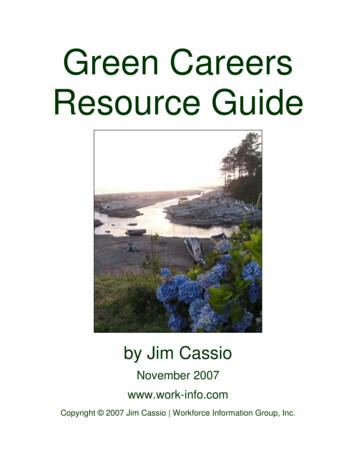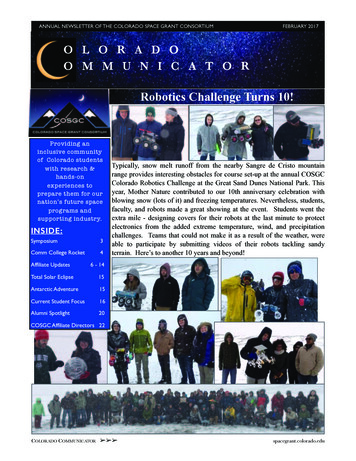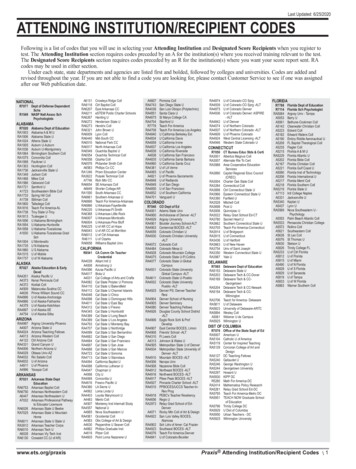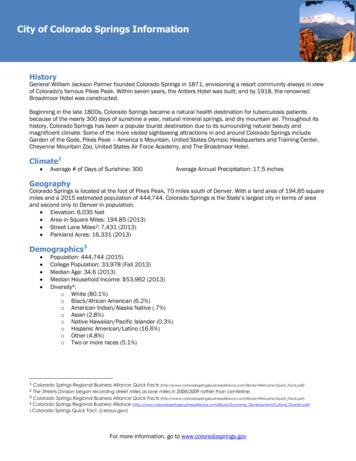
Transcription
Green CareersResource Guideby Jim CassioNovember 2007www.work-info.comCopyright 2007 Jim Cassio Workforce Information Group, Inc.
Table of ContentsPage3Introduction3A Green Birth3Defining Green Careers4Identifying Green Occupations5Initial Assessment of the List of Occupations5Occupation vs. Job5Wages Comparison6Education and Training Levels7Career Clusters/Pathways8Green Occupations by Career Cluster9Career Interest Areas1011-13Green Occupations by Career Interest AreaEmployment Statistics for Green Occupations14Occupational Information Sources15New and Emerging Occupations16-32Occupation Definitions and Major Employment Sectors33-35Resources: Articles and Publications36-39Resources: Websites and Job Boards40About Mainstream Job Boards41About Our Sponsor: CareerDNA41About Jim Cassio2
Green Careers Resource GuideIntroductionYou don’t have to be an environmental activist to be interested in a Green Career. You just need to be interested inwork that involves preserving and protecting the environment. Certainly many people who consider themselves to beenvironmentalists or environmental activists look to green careers as an important part of their lifestyle. But others,too, are likely to be interested in green careers simply because of their strong affinity for nature.A Green BirthThe modern environmental movement in the United States began to appear following the publication of Silent Springin 1962 by Rachel Carson. She was a biologist and a former researcher for the Fish and Wildlife Service. Carson hadthat rare ability to communicate complex issues in a way that most people could understand. Her book, Silent Spring,made people aware of how the indiscriminate use of the insecticide DDT spread throughout the food chain. Its title,“silent spring,” refers to the death of robins from DDT toxicity. Carson effectively presented the widespread harm thatpesticides cause to wildlife, as well as the damage that agricultural runoff did to waterways. The realization that newsynthetic chemicals widely used in agriculture and industry had potentially disastrous consequences captured theattention of many.Environmentalism was a major part of the social protest movements of the 1960s, and by the beginning of the 1970s,the foundations of the environmental movement were well laid for what would be called the Green Decade.Numerous public and private organizations formed to promote pro-environmental causes. The result was a collectionof environmental laws and agencies intended to incorporate environmentalism into government. Public support forenvironmentalism blossomed; however, the early success of the environmental movement also created a significantbacklash based on economic concerns and a growing criticism that environmentalists were too radical.The 1980s would be a challenging time of transition for environmentalists as they struggled to maintain their gainswhile their opposition went on the offense. By the end of the ‘80s, the environmental movement had survived thebacklash of the Reagan-Bush era. Despite efforts to deregulate and dismantle environmental protection agencies, astrong legal foundation to promote environmental issues remained.The environmental movement was largely an American cultural phenomenon until the late 1980s whenenvironmentalism became a global movement that culminated in the Earth Summit of 1992. Green political partiesbegan to appear in Germany and other countries and began to gain some political power. But in America during the‘90s, opponents of the environmental movement continued to proliferate and attempted to counter the movement’sinfluence. The backlash against environmental activism continued. Critics referred to most environmentalists as LiteGreens – those who like the idea of protecting the environment but are not willing to make any real sacrifices. But bythe end of the decade, the environmental movement had become an institution, both in the United States andglobally. The movement clearly had made Americans more aware of their environment than at anytime in theirhistory. Nevertheless, inertia due to the complex and sometimes apocalyptic nature of the environmental debate oftenleft people confused, skeptical, and apathetic.More recently, environmental awareness does seem to have made Americans sensitive to the long-term connectionsbetween our living standards and the preservation of nature. Faced by such real catastrophic disasters as globalwarming and extinction of species, many Americans are now moving from that state of hopelessness or indifferenceto a state of wanting to do something meaningful. For many, a green career is one way of doing somethingmeaningful.Defining Green CareersA green career is a job or series of jobs for which the common thread is environmental protection and preservation. Itdoesn’t matter what sector one works in, or who they work for. It also doesn’t matter whether it’s a hands-on field job,or a lab or office job, or something else. What matters is whether the job is about preserving and protecting theenvironment, and you can’t necessarily determine that by the job or occupation title. Many green jobs have the wordenvironment (or environmental) in the title, but you still need to research that specific job and that specific employerbefore you can be sure that it’s a true green job. Even with the occupations identified below, keep in mind thatan occupation is not a job; rather, an occupation represents similar jobs. So, within an occupation, you cancertainly have some jobs that are green and some that are not green.3
Identifying Green OccupationsThe O*NET system (from the U.S. Department of Labor) is the nation's primary source of occupational information,providing comprehensive information on key attributes and characteristics of workers and occupations. The FederalGovernment’s occupational taxonomy divides the U.S. workforce into about 900 different occupations. Using theO*NET database, occupations with significant biology knowledge and environmental monitoring requirements wereidentified.Occupations were also included on the basis of job tasks that involve preserving and protecting the environment.Then, to reduce this list of occupations to a manageable size, most health care and animal care occupations withhigh biology knowledge requirements were eliminated.Finally, administrative support occupations were not included, although that’s not to suggest that a secretary with anenvironmental consulting firm isn’t working in a green job!Here is the list of 77 Green Occupations - not a magic number by any means - but perhaps a good starting point:(Note that this list does not include a handful of new/emerging occupations that will be discussed in a later section.)1.2.3.4.5.6.7.8.Agricultural EngineersAgricultural InspectorsAgricultural Sciences Teachers, PostsecondaryAgricultural TechniciansAnimal ScientistsAquacultural ManagersAtmospheric and Space ScientistsAtmospheric, Earth, Marine, and Space Sciences Teachers,Postsecondary9. Biochemists and Biophysicists10. Biological Science Teachers, Postsecondary11. Biological Technicians12. Biologists13. Biomedical Engineers14. Chemical Technicians15. Chemistry Teachers, Postsecondary16. Chemists17. Civil Engineering Technicians18. Civil Engineers19. Commercial Divers20. Construction Carpenters21. Construction Managers22. Electrical Engineers23. Electricians24. Engineering Managers25. Engineering Teachers, Postsecondary26. Environmental Compliance Inspectors27. Environmental Engineering Technicians28. Environmental Engineers29. Environmental Science and Protection Technicians, IncludingHealth30. Environmental Science Teachers, Postsecondary31. Environmental Scientists and Specialists, Including Health32. Epidemiologists33. Farm and Home Management Advisors34. Farmers and Ranchers35. Fire Inspectors36. Fire Investigators37. Fire-Prevention and Protection Engineers38. First-Line Supervisors/Managers of Animal Husbandry andAnimal Care Workers39. First-Line Supervisors/Managers of Aquacultural Workers40. Fish and Game Wardens41. Forest and Conservation Technicians42. Forest and Conservation Workers43. Forest Fire Fighters44. Forest Fire Fighting and Prevention Supervisors45. Forest Fire Inspectors and Prevention Specialists46. Foresters47. Forestry and Conservation Science Teachers, Postsecondary48. Geographers49. Geography Teachers, Postsecondary50. Geological Sample Test Technicians51. Geophysical Data Technicians52. Geoscientists, Except Hydrologists and Geographers53. Government Property Inspectors and Investigators54. Hazardous Materials Removal Workers55. Health Educators56. Health Specialties Teachers, Postsecondary57. Hydrologists58. Industrial Safety and Health Engineers59. Lawyers (Environmental Law)60. Medical and Clinical Laboratory Technologists61. Medical and Health Services Managers62. Medical Scientists, Except Epidemiologists63. Microbiologists64. Municipal Fire Fighters65. Municipal Fire Fighting and Prevention Supervisors66. Natural Sciences Managers67. Nuclear Monitoring Technicians68. Nursery and Greenhouse Managers69. Occupational Health and Safety Specialists70. Park Naturalists71. Range Managers72. Soil and Plant Scientists73. Soil and Water Conservationists74. Training and Development Managers75. Tree Trimmers and Pruners76. Water and Liquid Waste Treatment Plant and SystemOperators77. Zoologists and Wildlife Biologists4
Initial Assessment of the List of OccupationsOne of the first things a person might notice when scanning this list of 77 occupation titles is the predominance ofscience-related occupations. Of course, since biology knowledge and environmental monitoring criteria were used tohelp create the initial list, the percentage of science-related occupations comes as no real surprise. But as thepurpose of this list is to provide useful career exploration content for people interested in real jobs for green careers,we think the science bias is appropriate.Green careers are largely science-based, unless you want to be pushing paper, giving park tours, or doingenvironmental compliance work. You can get a degree in Environmental Philosophy, but then you'll likely find out thatthere are no jobs for you without also having the science background. Without it, you'll end up going back to college.-Jessica Carson, Environmental ScientistAlthough the science bias may be appropriate for the purpose of this resource guide, one should not forget theexample of administrative support occupations which are found in every industry, including those involved inpreserving and protecting the environment. Of course, there are countless other occupations where a person’s workcan have a positive effect on the environment. For example: the artist whose work or inspiration reflects a love andunderstanding of the natural world; the journalist or writer who chooses stories or subjects where they can helpeducate the population about important environmental issues; the elementary or secondary school teacher who takesevery opportunity to instill in their students a love and respect for the environment; the elected public official whochampions causes that preserve and protect the environment; and the fundraiser and their telemarketing staff whowork to raise money for non-profit environmental organizations or causes. The list goes on.Occupation vs. JobPerhaps another initial reaction to this list is that there are some occupations on the list that don’t seem likeenvironmental-related occupations. The thing to remember here is that an occupation is not a job, even though thosetwo words are often used interchangeably. Instead an occupation is a way of grouping jobs that have similar tasks.Within a single occupation, therefore, you will have some variance. Surely most of the jobs filled by lawyers have littleor nothing to do with preserving and protecting the environment. But some lawyers specialize in environmental law;therefore there are some jobs within the occupation of Lawyer that are green. Another example is the occupation ofConstruction Carpenters, where the typical carpenter job has little or nothing to do with preserving and protecting theenvironment. However, there is an increasing need and demand for energy-efficient housing and other constructionthat will utilize solar or other forms of renewable energy. So the carpenters and general building contractors whomanage to develop a specialty in this field will be working in green careers.Wages ComparisonMost career explorers are going to want to know how green occupations pay compared to other occupations.Unfortunately, that’s difficult to determine with any certainty because within most of these green occupations you canhave some jobs that are green and some that are not green. Also, the criteria used to put together this list of 77occupations are biased toward science-related occupations. Nevertheless, the average wage for these 77occupations is just over 53,000 per year, which compares to an average of about 40,400 per year for alloccupations (when each occupation is weighed equally).5
Education and Training LevelsIn terms of typical education and training levels, 55 of the 77 occupations (or 71 percent) require a college degree.The other 22 occupations (29 percent) do not typically require a college degree; however, 9 of those 22 occupationsdo require extensive experience.Number ofOccupations1Typical Education LevelShort-term training3Moderate-term training9Long-term training9Extensive experience0Postsecondary certificate10AA/AS degree17BA/BS degree0BA/BS training7BA/BS experience4MA/MS degree16Doctoral degree1Professional degreeDescriptionShort-term period (less than 1 month) of employer-provided instruction ortraining is the typical education/training requirement.Moderate-term period (1-12 months) of employer-provided instruction ortraining is the typical education/training requirement.Long-term period (2-4 years) of employer-provided training orapprenticeship-based training is the typical education/training requirement.Extensive and related work experience is the typical requirement.Postsecondary technical or vocational training specific to the occupation isthe typical education/training requirement.An associate degree (2 years of college) is the typical education/trainingrequirement.A bachelor degree (4 years of college) is the typical education/trainingrequirement.A bachelor degree plus completion of a 1-2 year teacher training program isthe typical education/training requirement.A bachelor degree or higher plus extensive experience in relatedoccupations is the typical requirement.A masters degree (6 years of college) is the typical education/trainingrequirement.A doctoral degree (8 years of college) is the typical education/trainingrequirement.A professional degree is the typical education/training requirement.Note: See the table with the employment statistics for the typical education levels assessed for each occupation.6
Career Clusters/PathwaysIn terms of the 16 career clusters/pathways defined by the U.S. Department of Education, the majority of the 77occupations fall into one of two clusters: 1. Agriculture/Natural Resources and 2. Scientific Research/EngineeringNumber ofOccupations23Career ClusterAgriculture, Food &Natural Resources4Architecture &Construction0Arts, A/V Technology& Communications1Business,Management &Administration12Education & TrainingDescriptionThe production, processing, marketing, distribution, financing, and developmentof agricultural commodities and resources including food, fiber, wood products,natural resources, horticulture, and other plant and animal products/resources.Careers in designing, planning, managing, building and maintaining the builtenvironment.Designing, producing, exhibiting, performing, writing, and publishing multimediacontent including visual and performing arts and design, journalism, andentertainment services.Business Management and Administration careers encompass planning,organizing, directing and evaluating business functions essential to efficient andproductive business operations. Business Management and Administrationcareer opportunities are available in every sector of the economy.Planning, managing and providing education and training services, and relatedlearning support services.0FinancePlanning, services for financial and investment planning, banking, insurance,and business financial management.2Government & PublicAdministration3Health Science0Hospitality & Tourism0Human ServicesExecuting governmental functions to include Governance; National Security;Foreign Service; Planning; Revenue and Taxation; Regulation; andManagement and Administration at the local, state, and federal levels.Planning, managing, and providing therapeutic services, diagnostic services,health informatics, support services, and biotechnology research anddevelopment.Hospitality & Tourism encompasses the management, marketing andoperations of restaurants and other foodservices, lodging, attractions,recreation events and travel related services.Preparing individuals for employment in career pathways that relate to familiesand human needs.0InformationTechnology9Law, Public Safety,Security &CorrectionsManufacturing20230Marketing, Sales &ServiceScience, Technology,Engineering &MathematicsTransportation,Distribution &LogisticsBuilding Linkages in IT Occupations Framework: For Entry Level, Technical,and Professional Careers Related to the Design, Development, Support andManagement of Hardware, Software, Multimedia, and Systems IntegrationServices.Planning, managing, and providing legal, public safety, protective services andhomeland security, including professional and technical support services.Planning, managing and performing the processing of materials intointermediate or final products and related professional and technical supportactivities such as production planning and control, maintenance andmanufacturing/process engineering.Planning, managing, and performing marketing activities to reach organizationalobjectives.Planning, managing, and providing scientific research and professional andtechnical services (e.g., physical science, social science, engineering) includinglaboratory and testing services, and research and development services.Planning, management, and movement of people, materials, and goods byroad, pipeline, air, rail and water and related professional and technical supportservices such as transportation infrastructure planning and management,logistics services, mobile equipment and facility maintenance.7
Green Occupations by Career ClusterAgriculture, Food & Natural ResourcesGovernment & Public Administration Agricultural InspectorsAgricultural TechniciansAnimal ScientistsAquacultural ManagersEnvironmental Engineering TechniciansEnvironmental EngineersFarmers and RanchersFire InspectorsFirst-Line Supervisors/Managers of Animal Husbandry andAnimal Care WorkersFirst-Line Supervisors/Managers of Aquacultural WorkersForest and Conservation TechniciansForest and Conservation WorkersForestersGeological Sample Test TechniciansGeophysical Data TechniciansNursery and Greenhouse ManagersPark NaturalistsRange ManagersSoil and Plant ScientistsSoil and Water ConservationistsTree Trimmers and PrunersWater and Liquid Waste Treatment Plant and SystemOperatorsZoologists and Wildlife BiologistsHealth Science Civil Engineering TechniciansCommercial DiversScience, Technology, Engineering & Mathematics Construction CarpentersConstruction ManagersElectriciansHazardous Materials Removal WorkersTraining and Development ManagersEducation & Training Fire InspectorsFire InvestigatorsFish and Game WardensForest Fire FightersForest Fire Fighting and Prevention SupervisorsForest Fire Inspectors and Prevention SpecialistsLawyersMunicipal Fire FightersMunicipal Fire Fighting and Prevention SupervisorsManufacturingBusiness, Management & Administration Medical and Clinical Laboratory TechnologistsMedical and Health Services ManagersOccupational Health and Safety SpecialistsLaw, Public Safety, Security & CorrectionsArchitecture & Construction Environmental Compliance InspectorsGovernment Property Inspectors and InvestigatorsAgricultural Sciences Teachers, PostsecondaryAtmospheric, Earth, Marine, and Space Sciences Teachers,PostsecondaryBiological Science Teachers, PostsecondaryChemistry Teachers, PostsecondaryEngineering Teachers, PostsecondaryEnvironmental Science Teachers, PostsecondaryFarm and Home Management AdvisorsForestry and Conservation Science Teachers,PostsecondaryGeography Teachers, PostsecondaryHealth EducatorsHealth Specialties Teachers, PostsecondaryMedical and Clinical Laboratory Technologists 8Agricultural EngineersAtmospheric and Space ScientistsBiochemists and BiophysicistsBiological TechniciansBiologistsBiomedical EngineersChemical TechniciansChemistsCivil EngineersElectrical EngineersEngineering ManagersEnvironmental Science and Protection Technicians,Including HealthEnvironmental Scientists and Specialists, Including HealthEpidemiologistsFire-Prevention and Protection EngineersGeographersGeoscientists, Except Hydrologists and GeographersHydrologistsIndustrial Safety and Health EngineersMedical Scientists, Except EpidemiologistsMicrobiologistsNatural Sciences ManagersNuclear Monitoring Technicians
Career Interest AreasThe O*NET system rates occupations using the RIASEC career interest area categories. As you can see from thefollowing table, the vast majority of the Green Occupations are Realistic or Investigative type occupations.Number ofOccupations423208132RIASECCareer Interest ngConventionalDescriptionTools, Plants and Animals JobsAnalytical and Investigative JobsCreative and Artistic JobsPeople, Service and Teaching JobsLeadership, Enterprising and Sales JobsDetail, Data and Administrative JobsNote: While the above may suggest to the casual observer that green occupations are not appropriate for individualswith an artistic personality type, this would certainly be a false conclusion. This look at career interest areas wasconcerned only with primary interest area ratings. To that extent, it is true that none of the 77 occupations have theartistic category rated as the highest-rated interest area. However, there are a number of green occupations in whichthe artistic characteristics of the occupation rates as moderate or higher: Agricultural Sciences Teachers, PostsecondaryAtmospheric and Space ScientistsBiochemists and BiophysicistsBiological Science Teachers, PostsecondaryBiologistsChemistry Teachers, PostsecondaryChemistsCivil EngineersEngineering Teachers, PostsecondaryEpidemiologistsForestry and Conservation Science Teachers, PostsecondaryGeographersGeoscientists, Except Hydrologists and GeographersHealth EducatorsHealth Specialties Teachers, PostsecondaryHydrologistsLawyersMedical and Clinical Laboratory TechnologistsMedical and Health Services ManagersMedical Scientists, Except EpidemiologistsPark NaturalistsTree Trimmers and Pruners9
Green Occupations by (Primary) Career Interest Area Realistic Agricultural EngineersAgricultural InspectorsAgricultural TechniciansAnimal ScientistsAquacultural ManagersAtmospheric and Space ScientistsBiological TechniciansChemical TechniciansChemistsCivil Engineering TechniciansCivil EngineersCommercial DiversConstruction CarpentersConstruction ManagersElectrical EngineersElectriciansEngineering Teachers, PostsecondaryEnvironmental Science and Protection Technicians,Including HealthEnvironmental Scientists and Specialists, Including HealthFarmers and RanchersFirst-Line Supervisors/Managers of Animal Husbandry andAnimal Care WorkersFirst-Line Supervisors/Managers of Aquacultural WorkersFish and Game WardensForest and Conservation WorkersForest Fire FightersForest Fire Fighting and Prevention SupervisorsForest Fire Inspectors and Prevention SpecialistsForestersGeographersGeological Sample Test TechniciansGeophysical Data TechniciansHydrologistsMicrobiologistsMunicipal Fire FightersMunicipal Fire Fighting and Prevention SupervisorsNuclear Monitoring TechniciansNursery and Greenhouse ManagersRange ManagersSoil and Plant ScientistsSoil and Water ConservationistsTree Trimmers and PrunersWater and Liquid Waste Treatment Plant and SystemOperators Social Chemistry Teachers, PostsecondaryEngineering Teachers, PostsecondaryFarm and Home Management AdvisorsHealth EducatorsMedical and Health Services ManagersOccupational Health and Safety SpecialistsPark NaturalistsTraining and Development ManagersEnterprising Investigative Civil Engineering TechniciansCivil EngineersElectrical EngineersEngineering Teachers, PostsecondaryEnvironmental Compliance InspectorsEnvironmental Science and Protection Technicians,Including HealthEnvironmental Scientists and Specialists, Including HealthEpidemiologistsFire-Prevention and Protection EngineersForestersForestry and Conservation Science Teachers,PostsecondaryGeographersHealth Specialties Teachers, PostsecondaryHydrologistsIndustrial Safety and Health EngineersMedical and Clinical Laboratory TechnologistsMedical Scientists, Except EpidemiologistsMicrobiologistsNatural Sciences ManagersRange ManagersSoil and Plant ScientistsSoil and Water ConservationistsZoologists and Wildlife BiologistsAgricultural EngineersAgricultural Sciences Teachers, PostsecondaryAnimal ScientistsAtmospheric and Space ScientistsBiological Science Teachers, PostsecondaryBiologistsChemical TechniciansChemistry Teachers, PostsecondaryChemistsAquacultural ManagersConstruction ManagersEngineering ManagersFarmers and RanchersFirst-Line Supervisors/Managers of Animal Husbandry andAnimal Care WorkersFirst-Line Supervisors/Managers of Aquacultural WorkersGovernment Property Inspectors and InvestigatorsIndustrial Safety and Health EngineersLawyersMedical and Health Services ManagersNatural Sciences ManagersNursery and Greenhouse ManagersTraining and Development ManagersConventional 10Environmental Compliance InspectorsFire Inspectors
Employment Statistics for Green OccupationsOccupationJobs 2004Agricultural EngineersAgricultural InspectorsAgricultural Sciences Teachers,1PostsecondaryAgricultural TechniciansJobs 20143,3903,798 Very small13,64614,569 Very small1,628,1802,152,624 Very large22,615Animal Scientists25,646 Small2,6572Aquacultural ManagersAtmospheric and Space Scientists, includingMeteorologistsAtmospheric, Earth, Marine, and Space1Sciences Teachers, Postsecondary219,727Biochemists and Biophysicists1Biological Science Teachers, PostsecondaryRelativeSize3,000 Very small228,592 Large7,4108,636 Very small1,628,1802,152,624 Very large16,12419,514 Very small1,628,1802,152,624 Very largeBiological Technicians64,40075,475 MediumBiologists29,44234,461 SmallBiomedical Engineers9,700Chemical Technicians62,3461Chemistry Teachers, Postsecondary1,628,18012,700 Very small65,113 Medium2,152,624 Very largeChemists82,12788,100 MediumCivil Engineering Technicians93,549106,747 MediumCivil Engineers237,299Commercial Divers276,464 Large2,8763,148 Very small1,349,0341,534,617 Very largeConstruction Managers430,635475,276 Very largeElectrical Engineers155,904174,279 LargeElectricians656,227733,697 Very largeEngineering Managers190,366215,123 LargeConstruction Carpenters11,628,1803176,605Engineering Teachers, PostsecondaryEnvironmental Compliance Inspectors2,152,624 Very large197,123 LargeEnvironmental Engineering Technicians20,22725,167 Very smallEnvironmental EngineersEnvironmental Science and ProtectionTechnicians, Including HealthEnvironmental Science Teachers,1PostsecondaryEnvironmental Scientists and Specialists,Including Health49,25764,026 Small30,93435,967 Small1,628,1802,152,624 Very large73,37085,923 Medium11RelativeGrowthAbout as fastas averageMore slowlythan averageMuch fasterthan averageAbout as fastas averageAbout as fastas averageMore slowlythan averageAbout as fastas averageMuch fasterthan averageFaster thanaverageMuch fasterthan averageAbout as fastas averageAbout as fastas averageMuch fasterthan averageMore slowlythan averageMuch fasterthan averageMore slowlythan averageAbout as fastas averageAbout as fastas averageAbout as fastas averageAbout as fastas averageAbout as fastas averageAbout as fastas averageAbout as fastas averageAbout as fastas averageMuch fasterthan averageAbout as fastas averageFaster thanaverageMuch fasterthan averageAbout as fastas averageMuch fasterthan averageAbout as fastas averageMedianWage/Yr 60,340 31,340 70,610 30,630 43,170 50,720 71,450 65,250 68,700 63,750 34,340 58,900 73,900 38,620 57,340 57,090 38,640 65,280 37,220 35,140 70,770 72,770 42,220 99,000 74,840 48,530 39,980 67,620 35,480 61,490 51,950Typical eAA/ASdegreeBA/BSdegreeBA/BS ensiveexperienceBA/BSdegreeLong-termtrainingBA/BS eeBA/BSdegreeAA/ASdegreeDoctoraldegreeMA/MSdegree
EpidemiologistsFarm and Home Management AdvisorsFarmers and RanchersFire Inspectors4Fire Investigators45Fire-Prevention and Protection EngineersFirst-Line Supervisors/Managers of AnimalHusbandry and Animal Care WorkersFirst-Line Supervisors/Managers ofAquacultural WorkersFish and Game Wardens6,039 Very small15,85417,081 Very small1,064,951910,316 Very largeDecline12,91212,200 Very smallDecline12,91212,200 Very small26,52030,081 Small60,51362,689 Medium60,51362,689 MediumDeclineAbout as fastas averageMore slowlythan averageMore slowlythan averageAbout as fastas averageMore slowlythan average7,4418,222 Very smallForest and Conservation Technicians32,61134,778 SmallForest an
43. Forest Fire Fighters 44. Forest Fire Fighting and Prevention Supervisors 45. Forest Fire Inspectors and Prevention Specialists 46. Foresters 47. Forestry and Conservation Science Teachers, Postsecondary 48. Geographers 49. Geography Teachers, Postsecondary 50. Geological Sample Test Technicians 51. Geophysical Data Technicians 52.











